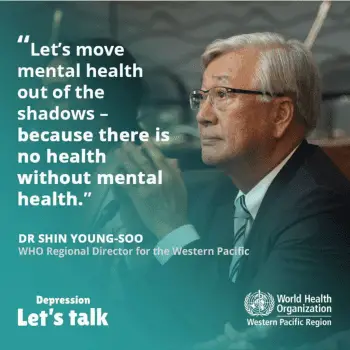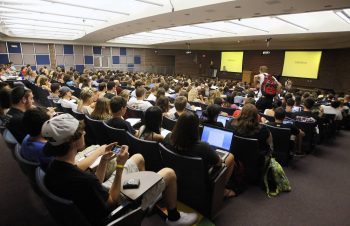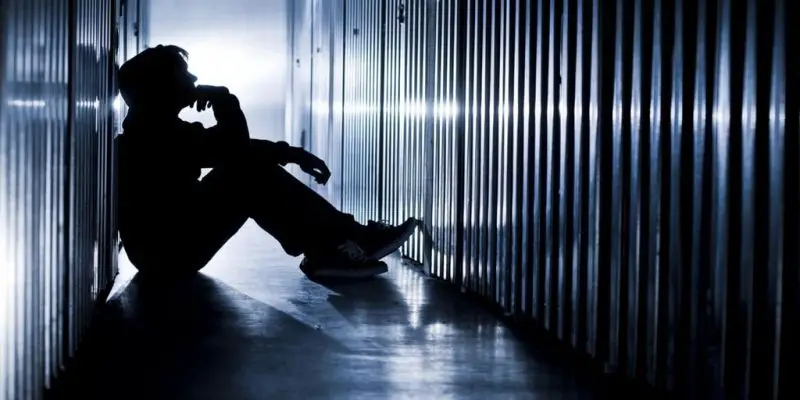By Andreas Toupadakis Ph.D
Contributing writer for Wake Up World
“Student mental health… is the elephant in the room that no one is talking about.” ~ Richard Kadison from Harvard University, author of ‘College of the Overwhelmed: The Campus Mental Health Crisis and What to Do About It’
Michael (not his real name), after I had been acquainted with him for a few months, walked into my office one day and confessed to me what made him behave oddly every time he visited me. “Dr. Toupadakis, every day I have thoughts to kill and rape.” Michael had been visiting me often at my office and he had taken one of my two first-year seminars. Michael was a likeable, wonderful young man, who slowly had come to trust me. I could see something was not all right since the beginning we met, but I could not figure out what it was. I was at a loss after his grave statement. I did not know how to respond and what to do.
I never expected to be in such a predicament being a chemistry teacher. After all, I never studied psychology or psychiatry, I just studied chemistry. I brought him that night to his dorm and while sitting with him in my car, I tried to encourage him to visit the appropriate services of the university for help. From his response, I found out that before he was accepted to the university, he was under medication. But, he decided to stop taking it because, as he said, he was afraid of the side effects. He made it clear to me that he did not want to visit the psychological services of our college.
[pro_ad_display_adzone id=”110028″]
In a few days, he informed me that his father would be visiting him and I expressed my interest to meet with him. Fortunately, he accepted my request and we met at my office in the afternoon right after my seminar. Michael and his father, two other of my students and I had a wonderful long dialogue that night during which I found out that Michael was diagnosed with schizophrenia well before he was accepted to college. I tried to explain to his father that his son needed help, a lot of love, and perhaps, the best course of action would be to take him home and take a break from school for a while. The next morning, Michael walked into my office early in the morning, gave me a heartfelt embrace and told me that he was leaving with his father that day. After a year or so, I called to see how he was doing. He said he was taking medication and was trying to decide what to do next.
After three years Michael has not come back on campus and I have not heard from him, but he is fortunate. Why? Because his family lovingly took care of him. By chance I received a phone call 10 days ago and he asked for a recommendation letter in order to apply for a part-time job. Michael now lives in a small community of people that offers compassionate humane support for people recovering from extreme mind and mood states. Unfortunately, this is not the case for many students. Because of the existing stigma on mental illness many parents deny the reality of their children’s mental health and they do not want to hear anything about it. Their children being ignored and isolated are discouraged by their parents’ indifference to ask for help, and if they do and get diagnosed, they do not follow through for their healing. (Also see: Suicide: Falling Through the Cracks of Stigma.)
Universities as public institutions are responsible for offering on a yearly basis, education to parents on mental health, thus reducing the stigma and therefore encouraging their children to ask for help. The sad reality is, dozens of students like Michael come every quarter to ask for help due to being in a great variety and intensity of psychological pain. Some would accept the advice and go to the university services and be helped. Others would go, but soon stop going claiming that they feel those in service do not care about them and that they just want to medicate them. Others do not want to hear about going to the psychological services of our college at all until they find it impossible to keep up with their studies and eventually drop out of school.
I was never trained by my employer on how to detect and respond to students at high risk. I am only required to go through training every year for cyber security and sexual assault.
Conventional wisdom is asking each father and mother who has a son or daughter in college today the question, “How do you feel, after paying such high tuitions, to know that your child’s classmates or his/her roommates had been diagnosed with serious mental disorders even before entering college, are medicated now, but they have suddenly decided to stop taking their medication, and now are flooded with destructive thoughts? And no one knows that they stopped their medication!”
The 2006 University of California report [1] provides a real story of what happens when a student who suffers from psychological pain has been left on campus unattended. Please read the story toward the end of this article, A Student in Crisis: A Vignette, where a student had to sleep with a baseball bat as a way of defending herself as her roommate’s behavior became more threatening or volatile. This story points out the enormous utility of college resources when just one student is struggling mentally.
So, to each father and mother, “How do you feel, to know that your child who has been diagnosed with a serious mental disorder has decided to stop taking his/her medication, now suffering silently and has become a threat to his/her life and the life of his classmates and roommates?”
Which father or mother in their right mind would accept such a situation? But, that is exactly what is taking place in our campuses nationwide today — because, there are not any procedures, rules, or policies in place to manage these serious difficulties. And no one wants to rock the boat. We all have become compliant to a structure that serves none of us in the short or long run.
The cries of our children have not moved us yet. My hope is that this article will encourage an open and serious dialogue on student mental health at the national level, between administrators, faculty members, students, and parents.
The State of Student Mental Health
According to the World Health Organization (WHO), cases of depression have increased almost 20% in the past decade, making it the world’s leading cause of illness disability, affecting an estimated 322 million people worldwide, including more than 16 million Americans. Startlingly, suicide is now the 2nd leading cause of death for teens in the US.
According to the guide recently published by the University of California, “Promoting Student Mental Health: A guide for University of California faculty and staff”: [2]
“Across the nation more students are manifesting signs of emotional and psychological distress, reflecting a confluence of a multitude of factors affecting the current generation of students.”
Below are the messages of two students found in the handbook: [2]
“I’m so stressed over work all the time!
“Ahhhhhhhhhh! Please make it stop! Sometimes I consider suicide. It seems weird to actually say that word. Hah! But no, really, every time I cross a bridge here, I wonder what it would be like to jump. Maybe I’m just looking for attention? I haven’t told anyone. I doubt that anyone who is depressed and considering the ‘s’ word would go to counseling anyway. Does anyone notice that I’m suffering?”
—Anonymous Student
“I’m a sophomore here at UC … and I’ve been dealing with eating disorders for about six years now — two years with anorexia, four years with bulimia. Freshman year was full of new experiences and I was determined not to let my eating disorder get in the way of my social life/academics, but this year has been challenging. My GPA fell to a 2.8, and for two quarters now…
“I have barely left my room. Since most of my classes are large lectures, I can get away with not going to class and just reading the text at home, but I haven’t been to class for six days now. I know that I need help really badly, but at the same time, if I’ve managed to survive for years this way, then I’m sure I can keep doing it. I wish one of my professors would notice and send me for help.”
—Anonymous Student
On February 2, 2017 the New York Post published an article [5] titled “Suicide Wave Grips Columbia”, which states that “a disturbing wave of seven suicides and likely drug overdoses has swept through Columbia University so far this school year — and students say fiercely competitive academics and inadequate campus counseling programs are in large part to blame.”
Kara’s personal story [4] shows the tragedy that is played every day in the lives of many of our students. You can read her story at the end of this article.
We are in the midst of the most ruthless assault on the wellbeing of our youth in recorded or orally-preserved human history. This merciless assault is mounted unintentionally by all of us, the adults, on our youth. Our youth is not a commodity or product, but unintentionally that is the way we actually are treating them. And this is because we do not understand the current issues and the causes. If our youth find no any other choice but to end their lives, we are doing something fundamentally wrong.
The Current Issues and The Causes
Why have schools at every level become dead zones of imagination and creativity?
Henry A. Giroux has written many articles addressing this question. According to Giroux, it is so because we have allowed the apostles of corporate power to have their way. Thus, what we see now is an assault on critical thinking, with schools becoming testing centers, and teachers and students having less power.
Almost any educational reform we see today is market-driven instead value-driven. The neo-reformers are obsessed with standardization, assessment, high-stakes testing, memorization, convenience and consistency. The outcome is a pedagogy of stupidity and repression that is geared toward conformity and passivity, as H. A. Giroux notes. But are not all these undermining student mental health?
“Every topic is taught in isolation and communicated by way of sterile pieces of information that have no shared meanings in context. A pedagogy of repression defines students and teachers largely by their shortcomings rather than their strengths, and in doing so convinces them that the only people who know anything are the experts. Students are taught only to care about themselves and to view any consideration for others as a liability, if not a pathology.” ~ H.A. Giroux [9]
Is this not a pedagogy that kills the creative spirit, promotes conformity and finally brings depression? Is this type of pedagogy suited for an authoritarian society or a democracy?
In trying to cope with the speed of many changes around us, most of us have lost the vision of who we are and why we are here. In other words, we are in a state of confusion, and when alone with ourselves, which is by now very rare to be, we do know down at the core of our being that most of us live a meaningless life, more or less just paying the bills and lacking true joy. True joy, creativity and vitality have been replaced with depression, fear and uncertainty as the consequence of a mind that is in a continuous state of competing, chattering, dividing, and calculating. And this is because we have sacrificed creativity and meaning for convenience and consistency.
Quality has been replaced by quantity. Books of science we studied in college 40 years ago had 200 pages but today have more than 1000 pages. Our books at that time did not have color and had very few drawings for clarity and no pictures at all. But we actually learned and without stress. The accumulation of data in every subject is inevitable — but how much can our students handle? We throw at them such an unreasonable amount of material with a speed of a cannon. No wonder we have been in the middle of a national campus mental health crisis for many years.
Dan Schwartz [6], Dean of Stanford’s Graduate School of Education, says that “the large lecture, and racing through material, doesn’t allow you to slow down to see the beauty of what you’re learning.” Racing through material, as Dan Schwartz points out, has serious consequences on student mental health, but almost no one talks about this. Most teachers and administrators have a ready answer to give the students, “It’s good for you, it will strengthen you and get you ready for the real world.” For sure if these teachers and administrators were willing to become aware of the statistics on mental health on campuses, they would never respond that way. If they had seen how many students are forced to give up their studies, or stay on campus but be in mental anguish day after day, surely they would take action to change things.
But, as the quality of education continues to decline, tuition fees and student debt are soaring while employment opportunities become more competitive, further contributing to the pressures faced by students. Explains Stephen Buckley from the mental health charity, Mind:
“Today’s students face an unprecedented financial burden with student loan and tuition fee debt higher than ever before. … On the other side of this is the financial stress and uncertainty around employment on graduation. Both of these are major contributors to mental health problems like anxiety and depression.”
Sleep deprivation and long work hours are also a significant contributor to the decline in student mental health. As Gregg Henriques, Ph.D, explains in the article, The College Student Mental Health Crisis:
“When we look at lifestyle habits… we also see evidence of markedly increasing maladaptive patterns. Sleep deprivation is legendary in college life, and many wear it almost as a badge of honor. Yet, with college students averaging just over 6 hours of sleep and the serious problems associated with sleep deprivation clearly documented, the poor sleep patterns are not to be taken lightly and are likely significantly associated with mental health problems in other domains.”
Curriculum makers are responsible to a great degree for the existing situation. Our kids are overloaded, and the teachers are going along with it. Parents and students have the power to demand change. But most parents do not realize that they send their children to invisible mental war zones. Campuses in our nation have become so. Messages coming from TV monitors distributed around the campuses, and messages exchanged between students and between teachers and students, promote unhealthy competition thus stimulating student mental problems. Is this preparing our kids for “the real world”?
Some societies and parents encourage their high school graduates to take a 2-year break before they go to college, and that is a very healthy approach. In that 2-year period, they work and they also travel. After this break they feel prepared to go to college. The decision is theirs, because now they are convinced that it is a good idea to go to college. They recognize that in that way they will have more choices in the future. Societies that do not encourage their high school graduates to take a break before they go to college, out of fear that their youth might eventually not consider going, end up having college students that do not know why they are in college. They turn out to be stressed out, confused and bored, and in their effort to relieve their mental pain, they find self-destructive coping mechanisms that further increase their mental anguish.
To address the problem of student mental health, some university school administrators have formed faculty committees to review their mental health services and make recommendations about how to improve them. But, for most universities, the presence of students and teachers who are in direct contact with the students, for dialogue and decision-making, is practically zero.
If we truly want to have a more joyous tomorrow and a chance to survive as a species on earth, we need to create “Ministries of Youth Empowerment.” We as parents, students, teachers, and administrators, should sit together around the same table with open hearts and minds, to not only preserve but increase the wellbeing of our students. However, from my own experiences and the experiences that I hear from my colleagues at other universities around the country, any individual effort on campus to start an open dialogue about mental health is considered a sensitive issue and is instantly shut down at every level of the chain-of-command. In other words, no involvement or participation of parents, students and teachers is encouraged or even allowed in the process of creating healthy learning environments. We do not realize that by supporting exclusiveness, we promote conflict. It is an inner conflict which is clearly seen in the statistical data on mental health in all university campuses.
When this inner conflict does not find expression, it produces unenthusiastic, lifeless and confused students. When it finds inner expression, it leads to fear, depression and suicide. But, when it finds outer expression, it invariably leads to tragedies.
[pro_ad_display_adzone id=”110030″]
Apparently no university is willing to take the lead to break the veil of secrecy, supported by an existing stigma on mental health, because such a move would bring a bad image to that university. But every university faces the same challenge. So, the question is: Who will rock the boat first?
At the same time that this unwillingness to start an open dialogue is in its highest, an unprecedented number of students are struggling mentally and suffering silently. In addition, teachers are very busy with learning how to use the ever-changing technology for teaching. It has become almost awkward these days to teach without using technology all the time. We are so greedy of how to increase student enrollment, tuition and buildings instead of providing quality of education. Also, parents fail to understand that their children on campus face much more than homesickness, transition and developmental challenges.
According to the 2015 National College Health Assessment report [11] published by the American College Health Association, over a 12-month period:
- 47% of students felt things were hopeless
- 35% of students felt so depressed it was difficult to function
- 9% of students seriously considered suicide
The mental health crisis is not only hitting high school students and undergraduates, but also graduate students. A science department of a well-known large university lost four graduate students and one postdoctoral scholar over a 1.5-year period, with only one confirmed cause of death. Would it be a wrong assumption to consider those deaths as suicides?
According to a 2015 Center for Collegiate Mental Health (CCMH) report [10] published by Penn State University, data from 93 institutions showed, on average, an increase in the number of students seeking services at counseling centers (+29.6 percent), which was more than 5x, the rate of institutional enrollment (+5.6 percent). Further, the increase in counseling center appointments (+38.4) was more than 7x the rate of institutional enrollment.
- 21% of students presented with severe mental health disorders, while another 40% presented with mild mental health concerns
- Anxiety was the most predominant presenting concern among college students (56.9%), followed by stress (46.6%), depression (45.9%) and family problems (31.6%). Other common concerns were relationship problems (29.1%), academic performance (28%), adjustment to new environment (14%), grief and loss (12%), and suicidal ideation (9.6%)
- On average, 33.4% of students have already taken psychotropic medication by the time they enter the university
Furthermore, a report from the National Alliance on Mental Illness (NAMI) in 2015 noted that approximately 64 percent of students who withdrew from college cited they were not attending due to mental health related reasons.
Why is a University Named a “University”?
“When universities were first created, they were meant to embrace and portray an endless and vast vision, an expanse that encompasses humanity and stretches throughout the universe. That is why a “university” is so named… [It is] a place devoted to understanding ourselves, the nature of the wider universe and its workings, and our place in it.” [7]
In the past, education was not just about training students for a specific job, as we do today. The aim of a university many years ago was two-fold; to convey knowledge, but in addition and most importantly, to activate an intrinsic wisdom possessed by all individuals. In other words, the aim is to transform the student. Liberal education was not to indoctrinate, but to transform. To develop this capacity, what is required is dialog and self-reflection, both of which are missing from today’s education in large part because of the large size of lecture halls. The lack of dialog and self-reflection creates absence of meaning and thus, undermines mental health.
A great teacher states:
“The solution to most of the problems faced by society is value based education. When we study in colleges and universities, striving to become a doctor, a lawyer, an engineer, etc., it is education for livelihood. Education for life is the cultivation for expanding perception, which is understanding the nature of the world and the nature of our mind, which will help us to adjust to all the different situations that come in life.”
Specific Recommendations
Student mental health needs are increasing at unprecedented rates. Many studies show an unprecedented rate of increase of mental issues during the last 20 years or so. More students with chronic severe mental illnesses are arriving on each campus nationwide. Surprisingly as of now, there are no rules, college policy or national policy to give the right to universities to know who is coming and with what condition. Truly we are in a crisis now.
To be able to meet the educational goals of our students, we must first tend to their emotional needs. What changes can we make in curriculum? What is the appropriate/reasonable amount of material and delivery speed we should have? How much technology should we use for our teaching? To these questions and more, we must try to find answers working together as a well-intentioned team made up of students, teachers, parents and administrators in order to create healthier learning environments.
Based on my own experience and research, my specific recommendations include:
- Create a campus wide FACULTY COMMITTEE for STUDENT MENTAL HEALTH.
- Create a faculty committee for student mental health within each department, which will report to the main faculty committee for student mental health.
- Institutionalize mandatory annual TRAINING FOR FACULTY AND TEACHING ASSISTANTS on mental health on how to recognize and help students in distress. Faculty and staff already take required training every year on Cyber Security. Can we have cyber security without a healthy mind?
- Actively promote MEDITATION campus wide. Many colleges and universities are beginning to acknowledge the benefits of meditation and offering classes, programs and even dedicated facilities for students, staff and the general public. See: 30 Colleges Leading the Way in Meditation for Mental Health.
- BRING INSPIRATIONAL TEACHERS on a regular basis, every week or month to talk on the wellbeing of students. Advertise widely and campus wide.
- INSTITUTIONALIZE POLICIES for being able to know the students that are coming on campus with chronic mental challenges in order to help them on a regular basis. Thus, this also helps the rest of the students.
- Make such CHANGES IN THE CURRICULUM on every subject, so anxiety and stress is reduced. The amount of material taught to students and the speed given is totally unacceptable and destructive. Why is this happening? There is a reason, certainly!
Some people argue that the mental health issue is very complicated and difficult to handle, and that is absolutely true. But, was it not a very complicated and difficult issue to land on the moon? But, we resolved all issues and difficulties and achieved it. Would we have any prolonged suffering or grave consequences if we had not landed on the moon? How much more then, as humans, should we be willing to work to reduce our continuous mental suffering and that of our own children? If we are not peaceful and joyous, will our every moment decisions bring solutions or more problems in our lives?
In reality, the quality of student mental health has a lot to do with two important factors: the college size population, and on what our educational focus is based.
- Educational focus: If a college’s quality of education is based on research grants, titles and profit, will its students not suffer? But, if a college’s quality of education is based on values, self-awareness and inner growth, will its students not be happier and more successful?
- College size: Invariably students (and their parents) aim to attend the campuses of large universities, not realizing that their mental health is going to be greatly challenged by the experience, placing them at high risk. During recruiting tours on campuses, parents and students are shown the magnificent buildings and landscapes around, they hear about the type of research performed and how many dollars are brought to the university from different sources. But they do not realize how little these things have to do with mental health, education and subsequent success.
Before they decide where to give their money for their education, students and parents should ask questions like those below. And they should research to make sure that the answers for each university are true, and compare them with national average statistics and of other universities. The answers to these questions will tell you if you will be in a happy and healthy learning environment, or otherwise.
- How much of its budget does the university spend for undergraduate instruction? For example, UC only spends 5% of its budget for undergrad instruction, according to the California Teacher, Vol. 69, Number 2, page 15.
- What is the percentage of students that drop out without receiving their degree after 4 years?
- Of those that drop out, what is the percentage that drop out because of mental disabilities?
- What is the suicide rate?
- What is the percentage of the budget that goes into counseling and psychological services?
- What is the percentage of students that enter graduate education after their undergraduate studies?
- What is the rate of students admitted to hospital or arrested per year?
- What is the ratio of students/instructors?
- What percentage of teachers of undergraduate instruction are full time? How many of them were hired through national search and not “off the street”?
Further, universities must begin assessing the quality of teaching, and rewarding educators accordingly.
According to Nobel laureate Carl Wieman,[6]
“The quality of teaching is not something that university administrators are rewarded for, and correspondingly know or care about. If they improved the quality of teaching by 100 percent and in the process reduced the amount of research funding and publications by 1 percent, they would be penalized, since the latter is carefully measured and compared across institutions, while the former is never measured. …
“The fact that most colleges and universities don’t even bother to systemically measure teaching quality is the bigger problem festering in higher education. Administrators… are instead obsessed with publishing and research funding, which remain the bedrock of tenure and promotion.”
Wieman believes, as I do, that until administrators and faculty leaders prioritize teaching, schools will continue to shortchange undergraduates.
To achieve this goal, we can begin by leveraging the work of other progressive educational institutions. Stanford University Medical School, for example, has “The Center for Compassion and Altruism Research and Education.” We can invite its director and its researchers to hear what they have to say about compassion and mental health. In Stanford, compassion cultivation training is offered and Stanford’s President, Dean of the School of Medicine and Dean of the School of Humanities and Sciences, emphasize the importance of compassion at Stanford and beyond.
Other institutions are also taking action to better support their students. For example:
- “The University of Maryland offers for-credit courses to freshmen aimed at helping them deal with stress and time management. … Such courses are now offered by about two-thirds of the nation’s schools.”
- “The University of Rochester omits first-year grades from transcripts! It also assigns volunteer faculty members to groups of twenty to forty students to demystify the faculty.”
- “The University of South Carolina, the University of Nevada-Reno and Texas A&M offer in-depth seminars on the transition to college.”
- MIT is putting together support teams of physicians, other health care professionals, and experienced counselors to spend time in the dorms socializing with the students.
What we need is compassionate action.
“No student should feel as though ending their life is the only option.”
At its core, the real cause of all of our problems — including mental health — is our lack of compassionate action. More buildings, technology, conferences and classes are not going to take us out of the pit we are in. Definitely not! So, let us work together to turn over the current situation on student mental health.
It has become crystal clear that colleges around the nation in 2017 do not have adequate campus counseling programs. This situation must be addressed. And, until universities are able and decide to improve their counseling services, they should at least openly admit the challenges they face regarding student mental health. This is so that their students would not hope for the necessary help on campus when they need it, but go to ask for help outside of campuses or by returning home. In that way, our students are less likely to suffer silently or kill themselves.
Invariably, students with mental challenges are among the brightest minds, gifted with amazing talents, and are often individuals with some of the most excellent characters I have ever met during my career as a teacher. It is therefore no wonder they cannot fit in a world increasingly out of harmony, and into an educational system that predominantly enforces the learning of data and facts instead of expanding the horizons of human perception. We are losing our best minds to this historic epidemic, and the survival and progress of our world as we know it is in question.
Most importantly, the student mental health challenges that our nation faces, and to a good degree other nations also, will not find solutions unless parents and students become active in the process. Since they are the ones that pay the high tuition, they should first show interest and second be allowed to be part of the process towards finding solutions. To this day, their presence in the process is practically zero. It is time to demonstrate courage and feel compassion for our children in order to openly discuss the many unexplored possibilities we have for creating healthier learning environments.
The purpose of this article is to encourage an open and serious dialogue on student mental health at the national level, between administrators, faculty members, students, and parents. To better understand the nature and impact of our mental health crisis, please read the following personal stories, “A Student in Crisis: A Vignette” and “Being Depressed at UBS: Kara’s Story.”
Andreas Toupadakis
A Student in Crisis: A Vignette
Taken from the 2006 University of California report:
Carolyn (not the student’s real name) arrives for her Counseling Center appointment and complains to her counselor about academic difficulties and challenges with her residence hall suitemates who she believes are conspiring against her. She shows evidence of bizarre and disorganized thinking and reports a history of bipolar disorder and that she has been less than compliant with her medication regimen.
Over the course of the next several days, Carolyn’s mood and behavior continue to deteriorate.
She becomes more delusional and begins hallucinating. She acts in increasingly bizarre ways, carrying a blunt pair of scissors, intimidating other students, not attending classes or midterms, and yelling at imaginary people in the campus quad.
Roommates complain to the student Resident Assistants, who in turn, inform the professional residence hall staff about the student and the need for something to be done. By now, Carolyn’s roommate is rumored to be sleeping with a baseball bat as a way of defending herself if the Carolyn’s behavior becomes more threatening or volatile. Because complex policies, due process rights, and student safety are all at stake, the Director of Residence Life involves the campus Judicial Affairs Officer and the Dean of Students.
Subsequently, Carolyn speaks with her parents and decides to go home for several days. At home she sees her psychiatrist, who recommends that she be admitted to a hospital for psychiatric evaluation. Carolyn complies but, against her physician’s orders and advice, she signs herself out of the hospital the next day and returns to campus, creating significant anxiety among students and staff in her residence hall.
Two days later, shortly after 8:00 a.m., Counseling Center personnel are called by residence hall staff and asked to respond to their location and assist with a student who has reportedly been up all night screaming loudly, wandering the halls and outside premises, acting inappropriately. A psychologist comes to the residence hall and joins University police who have been on site for some time in response to an earlier call from the residence life staff. The client’s behavior is so bizarre that she is placed on a psychiatric (5150) hold and hospitalized involuntarily. The Vice Chancellor of Student Affairs is notified along with the campus student crisis response group who subsequently gather to evaluate the potential return of the student to campus, and the additional offices, personnel and faculty that may need to be informed or involved in managing her return and responding to the disruption she has already caused.
Formal and informal meetings among the suite mates and residence hall staff yield feelings of empathy, mixed with those of anxiety, anger, and frustration at the situation. Roommates are transferred to different residence hall buildings and are upset at having to move their place of residence (along with phone lines and mailing addresses), particularly during mid-term exams. Residential Life staff doesn’t believe Carolyn is an appropriate fit for group living, but are mindful of her right to due process if she is not willing to voluntarily forfeit her housing contract.
Some Resident Assistant staff, students themselves, are frightened and threaten to quit if Carolyn is allowed to return. Two parents of other student residents have called the Director of Residence Life and the Vice Chancellor for Student Affairs to express their dismay at the negative impact this situation is having on their children. At day’s end, the local newspaper places a call to the Campus Communications office asking for information based upon the generic entry in the University police log from the early morning hours.
The Communications office confers with the Vice Chancellor for Student Affairs, the Police Chief, the Dean of Students and the Director of Residence Life to confirm the facts of the case, clarify the privacy laws and policies that apply, and determine, in conjunction with campus legal counsel, the most appropriate response to the local reporter.
Kara’s Personal Story
Introducing Kara’s story, Dr. Paul Joffe, a clinician from Counseling Center, University of Illinois, Urbana-Champaign writes:
“The most painful thing I experience as a clinician is witnessing the amount of suffering that students endure before seeking help. They often suffer alone, which compounds the problem. They don’t want to burden parents or friends, and ironically that selfless desire increases their isolation, which further worsens the problem. They haven’t learned yet that sharing stress invites others to share their own stresses, solidifies connections and provides opportunities for new perspectives and solutions.
“I don’t think I can explain this state of pain and confusion better than Kara did in the following article that she wrote to her college newspaper when she was in her first year of graduate school as a business student. (With permission, I’ve changed names to protect the privacy of the individuals involved.)
“It took courage for Kara to write this article, but the results have been worth it. Every year the student newspaper runs this piece during National Depression Screening Week, and after it is printed, a number of students always come into the counseling center saying, “I have all the same symptoms that were in that letter but didn’t put it all together.”
“Being Depressed at UBS”
Kara’s personal story appeared at the end of this report from University of Illinois. [4]
I almost took my life three times during my first year at University Business School. And I was just as normal as you when I started here. I was really excited to come to UBS. The first month or two were filled with new friends, and great challenges. But then one day I noticed that I wasn’t feeling like myself anymore. I didn’t think much of it at the time, and it was no big deal.
Then it happened again. Soon I started to feel sad all of the time. I kept asking myself if I was really enjoying school here. Was everyone happy besides me? Why wasn’t I having any fun?
Maybe it was because the weather had started to turn cold and gloomy.
Perhaps I was overwhelmed by the zillions of recruiters calling me, when I was already confused about “what I wanted to do with the rest of my life.” Maybe I was starting to get sick of seeing the same 80 people every single day, and that annoying guy in the corner who pointed his finger whenever he raised his hand. Whatever it was that began it all…everything else was just piling up and making it even worse.
I began to find myself crying myself to sleep. I didn’t want to go out anymore. I stopped exercising, which only made me feel worse, both physically and emotionally. I started questioning everything I would say in class. I couldn’t focus on what the professor was saying. I felt like every case I read was longer than War and Peace.
I started hating myself for ever applying to UBS. And then one day I just didn’t get out of bed. I stayed in bed all day and just cried and cried.
Then a strange calmness came over me. “Everything would be all right if I just killed myself,” I thought. “Then it would all go away.” So I made my way to the bridge and stood there for nearly an hour. But I couldn’t jump off.
The next three weeks were the worst weeks of my life. I would spend class periods thinking of how to kill myself, and how that was the real answer to all of my problems. I skipped class just because I didn’t want to get out of bed. I went to the bridge two more times. I wasn’t scared anymore. I was ready to die and I didn’t care.
A friend saved me, without even realizing it. She thought I looked sad and suggested that I go see Dr. Patricia Miller, Director of MBA Program Support Services. That was the beginning of my road back to recovery.
Dr. Miller realized that I was severely depressed and she got me some help. I went and saw Dr. Nicole Johnson, a psychiatrist at UBS. I didn’t want to go at first. I was an UBS student, and I wasn’t about to go see a shrink. God forbid if anyone ever found out. I was supposed to be strong-a winner. Winners don’t go see psychiatrists or admit that they’re depressed. I felt like a complete failure for going to see Dr. Johnson.
But he helped me realize that I wasn’t. Every year the staff of the Mental Health Services department sees about 140 UBS students. That’s about 1 out of every 11 people. That’s 7 people in YOUR section alone. Not to mention the fact that there are many UBS students who go see outside providers without ever going through University Health Services.
I began to re-focus my life. Although I didn’t feel comfortable telling any of my friends that I was struggling, I did tell my parents. They, along with Dr. Miller, would call or email me every day to cheer my up and encourage me. I began forcing myself to exercise no matter how bad I felt. I sought out tutoring from some second years. And I began taking anti-depressants. That was a very difficult hurdle to overcome. I thought that surely I must be a loser if I was so depressed that I had to use medication to get better. I was scared of the side effects and of the possibility that people might find out. But once again Dr. Johnson calmed my fears.
Although I don’t know the exact numbers, I do know that, you walk by someone everyday that’s using Zoloft or Celexa or Prozac. You don’t even know it. And do you know why? Because the medicines work; and no one can tell the difference. Not everyone has to take medicine, but if you do, it’s nothing to be ashamed of or scared of. It simply means that you need a boost to get your positive brain waves going again.
Combining the medicine with daily exercise made all of the difference in the world. Within a month, I felt happy again from time to time. Within 2 months, I felt happy most of the time. Within 3 months, I was me again.
Why did I write this article you ask? Because I want you to know that it’s okay to be depressed but it’s not okay to stay depressed. That may sound stupid or simple to you if you feel fine. But it was exactly what I needed to hear when I wanted to end my life. I also want to remind you that it’s okay to ask for help.
And I pray that you do. You ask questions in class all the time. Why should you feel any embarrassment about asking for help when the answers provided are a million times more important than any ones you’ll ever hear in class?
I chose not to submit my name because this is a very private experience. However, it’s not an unusual experience. It’s all around you. Please take the time to look out for your friends and notice when they seem down.
But most of all, take care of yourself. UBS is an amazing place full of phenomenal people and fantastic experiences. The staff and faculty here want to help you make sure that you can benefit from every aspect of the UBS experience. You can only do this if you are healthy and happy.
Remember that I started out feeling fine too. Get help before you sink as low as I did. Your life and UBS are too precious to miss out on.
Help for Students:
- College Guide for Students with Psychiatric Disabilities: http://www.bestcolleges.com/resources/college-planning-with-psychiatric-disabilities/
- The Top Mental Health Challenges Facing Students: http://www.bestcolleges.com/resources/top-5-mental-health-problems-facing-college-students/
References:
- Student Mental Health Committee. Final Report. September 2006. University of California, Office of the President. http://regents.universityofcalifornia.edu/regmeet/sept06/303attach.pdf
- Promoting Student Mental Health: A guide for UC faculty and staff. http://www.ucop.edu/student-mental-health-resources/training-and-programs/faculty-and-staff-outreach/PSMH-Handbook.html
- College of The Overwhelmed: The Campus Mental Health Crisis and What to Do About It. By Richard Kadison (Chief of the Mental Health Service Harvard University Health Services), M.D. and Theresa Foy Diceronmo.
- Kara’s personal story is at the end of the report. Please scroll all the way down.
- Suicide Wave Grips Columbia. http://nyp.st/2kWNNMq
- http://www.npr.org/sections/ed/2016/04/14/465729968/a-nobel-laureates-education-plea-revolutionize-teaching
- https://www.drbu.org/academics/our-philosophy-education
- http://www.huffingtonpost.com/cris-rowan/10-reasons-why-handheld-devices-should-be-banned_b_4899218.html
- http://www.truth-out.org/news/item/18133-when-schools-become-dead-zones-of-the-imagination-a-critical-pedagogy-manifesto
- Center for Collegiate Mental Health (CCMH) 2015 Annual Report: http://ccmh.psu.edu/wp-content/uploads/sites/3058/2016/01/2015_CCMH_Report_1-18-2015.pdf
- American College Health Association 2015 National College Health Assessment report: http://www.acha-ncha.org/reports_ACHA-NCHAIIc.html
Also by Andreas Toupadakis Ph.D:
- Creating Your Future – Arise Great Warrior, Arise!
- Awaken Students! Education is for Self-Awareness and Inner Growth
About the author:
Born on the beautiful island of Crete in Rethymno, Greece, Andreas Toupadakis received his primary education while living in the mountainous village of Argiroupoli near the coast. After receiving his B.S. in Chemistry from the Aristotelian University in Thessaloniki, he began graduate school in the U.S. He has lived in the U.S. since 1978, and he received his Ph.D. degree in Chemistry from the University of Michigan in 1990.
Since 2005, Dr. Toupadakis has been teaching at UCDavis as a lecturer at the Department of Chemistry. The courses he teaches include the General Chemistry 2ABC series for first-year students majoring in science and engineering, the Organic Chemistry 118ABC series and the Organic Chemistry 8AB series for second-year students, and the Physical Chemistry for Life Sciences 107AB series for third- and fourth-year students. His scientific interests are in better teaching methods and chemistry book writing and reviewing. His lectures are tuned toward conceptual learning via the Socratic dialogue method.
He is the author of three chemistry study guides, CHEMISTRY READER 2A, CHEMISTRY READER 2B, and CHEMISTRY READER 2C and their corresponding solutions manuals, which have been received with great enthusiasm by students taking the CHEMISTRY 2ABC series, his teaching assistants, and colleagues. Andreas also teaches two popular freshman seminars at UC Davis every quarter entitled, “From Self-Awareness to Personal Growth for True Success in and After College” and “World Music as a Means to Embrace Diversity and Reach Self-Discovery”.
Besides teaching chemistry at UC Davis, he has also taught chemistry at several other colleges and universities in the U.S. and in Greece, including the University of Crete in Iraklion, and the Nutrition College at the Technology Education Institute in Sitia, Crete. Dr. Toupadakis has also worked at Los Alamos National Laboratory, Lawrence Livermore National Laboratory, and in industry at Dow Corning.
In addition, Dr. Toupadakis has given lectures and written articles on life planning through wise career choice, on career change and career satisfaction, and on sustainable living across campuses in the U.S., Greece, Japan and recently in India. His writings have appeared in a number of newspapers and electronic magazines. Andreas often reminds his students of Gandhi’s words, “Be the change you want to see in the world”; of Socrates’, “Know your Self”; of Einstein’s, “Imagination is more important than knowledge” and of Amma’s, “Where there is love there is no effort”.
Dr. Toupadakis has being tirelessly lecturing on environmental issues and peaceful solutions at universities and colleges, including MIT, Tufts University, the University of Notre Dame, San Francisco State University, U.C. Berkeley and Waseda University in Tokyo. In January 2000, Dr. Toupadakis resigned his position at LLNL and took his story public. His landmark resignation is a rare and inspiring case in which a scientist has left a weapons program to actively contribute the peace movement. Among other recognitions, Dr. Toupadakis was awarded the Alliance for Nuclear Accountability (ANA) Certificate of Honor in May 2000, for moral integrity of the highest order in refusing to work on nuclear weapons research and encouraging his colleagues to renounce this work as well. He spoke both times as a keynote speaker at the 2000 World Conference against A H Bombs in Hiroshima and at the Nuclear Non-Proliferation Treaty Review Conference at the United Nations in New York on May 3, 2000.
Dr. Toupadakis, together with his friends and students, has started to establish in Greece, two hours from Athens, “NECTAR,” (next to NOOSFERA) a place for living in and with nature. In NECTAR, community members will be connecting with the land while pondering and practicing the teachings of great teachers such as Socrates, Pythagoras and Apollonius of Tyana.
His personal web site, is devoted to student success during and after college. Dr. Toupadakis spends a great deal of his free time with his students at his organic garden plot, which is provided by the Experimental College Community Garden of UC Davis. He also encourages his students to have their own garden plots. The Department of chemistry of UCDAVIS in 2011 nominated him for the Academic Federation Award for Excellence in Teaching. He is the winner of the 7th annual ASUCD Excellence in Education Award as the overall educator of the year 2009 at UC Davis.
You can contact Dr. Toupadakis via email here.
[pro_ad_display_adzone id=”110027″]











